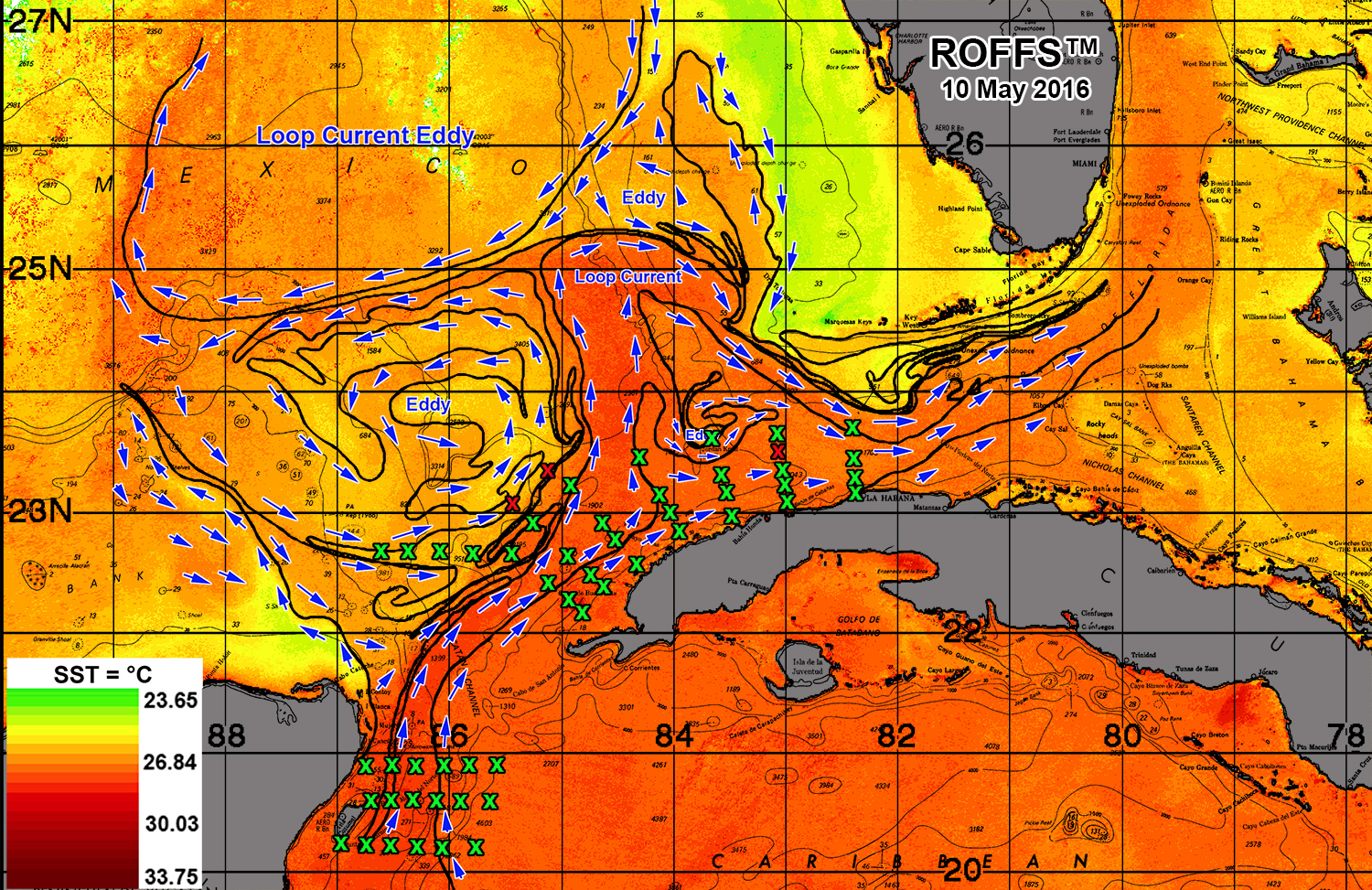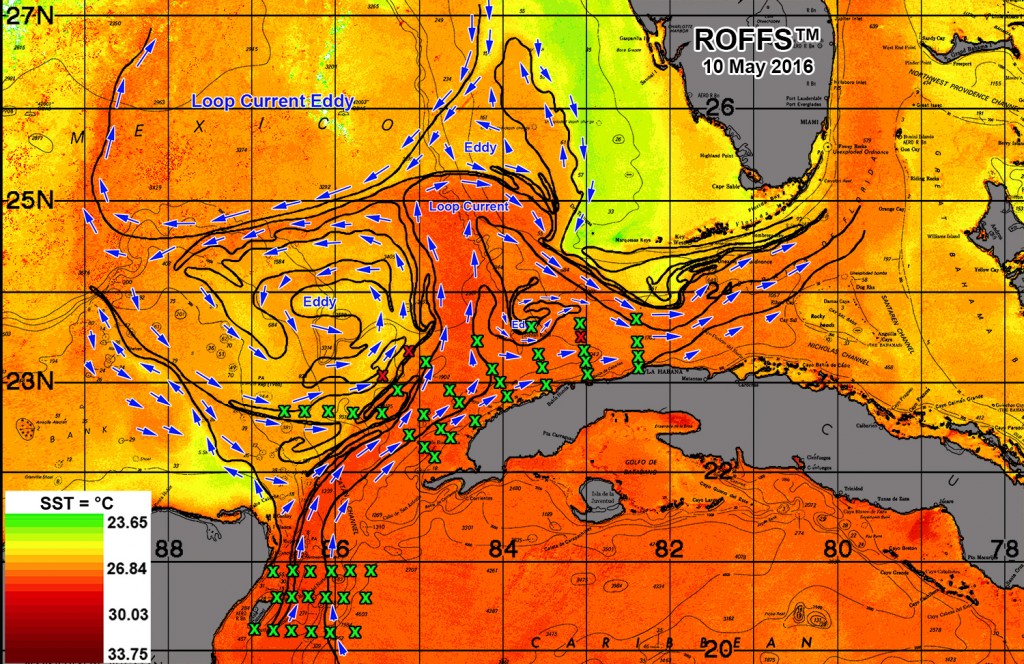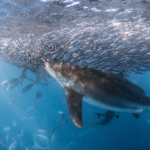Article Courtesy: omao.noaa.gov | Originally Published: May 17, 2016 | Please click here for original article.
ROFFS™ is helping NOAA research vessel find fish larvae off Cuba as part of our joint NASA – NOAA research project using satellite derived oceanographic analyses to assist in developing habitat models, in part by assisting NOAA’s field activities in the Gulf of Mexico, Caribbean Sea and Bahamas.
While the team has been working on this effort for years, the following is the project summary modified from our original proposal to NASA. This is a joint NASA – NOAA effort and more people are involved that are indicated here.
Above: Image is an example of one satellite derived oceanographic analysis that ROFFS™ derives on a daily basis for the research cruise. The analyses are derived by ROFFS™ and sent to John Lamkin on the NOAA vessel to assist in decision making.
Project Summary
Management And Conservation Of Atlantic Bluefin Tuna (Thunnus Thynnus) And Other Highly Migratory Fish In The Gulf Of Mexico Under IPCC Climate Change Scenarios: A Study Using Regional Climate And Habitat Models.
- PI: M. A. Roffer – ROFFS™
- Co-I: J.T. Lamkin (NOAA), F.E. Muller-Karger (USF), S-K Lee (UM CIMAS), B.A. Muhling (UM CIMAS), Y. Liu (UM CIMAS), M.A. Upton, (ROFFS™) & G. Gawlikowski (ROFFS™), G.W. Ingram (NOAA), G.J. Goni (NOAA)
- Some of the other collaborators added: W. Nero (NOAA), J. Franks (USM), J. Quattro (USC), Enfield (NOAA), John F. Walter (NOAA), Craig Brown (NOAA) A. Bakun (UM RSMAS), K. Ramirez (INAPESCA), F. Alemany (IEO), A. Garcia (IEO),
- Funded by NASA Earth Science Program: Start date September 06, 2011 – End date September 05, 2016
Proposal Summary
This “applications” research project focuses on enhancing the management of multiple important highly migratory pelagic fish species in the Gulf of Mexico and surrounding waters, with particular focus on Atlantic bluefin tuna (Thunnus thynnus) and other highly migratory tunas and billfishes. Our team has developed an innovative spawning habitat model for Atlantic bluefin tuna in the Gulf of Mexico in collaboration with the National Oceanic and Atmospheric Administration’s National Marine Fisheries Service (NOAA NMFS). The proposed study will leverage our present collaborations to project this habitat model into the future using IPCC climate models and scenarios to assess possible effects of climate change on the spawning habitat and fish population dynamics.
We will improve the present habitat model by re-analyzing a 28-year time series of NOAA NMFS SEAMAP ichthyoplankton surveys in the Gulf of Mexico, with historical fisheries analyses (commercial pelagic longline fishing observer data) in the Gulf of Mexico, and relevant historical oceanographic data including historical and concurrent satellite imagery. Specifically, we will assess the potential changes in habitat extent using outputs from the numerical simulations constructed for the fourth assessment report of the Intergovernmental Panel on Climate Change (IPCC AR4), which are being refined in preparation for the fifth assessment report (IPCC AR5). We will identify time periods over which average historical, synoptic environmental observations closely match the projected climate change scenarios in the entire North Atlantic, and study the spawning habitat of the various species and the distribution of adults as determined by fisheries statistics during such periods within the Gulf of Mexico using a high resolution downscaled mode of the IPCC models created using the Hybrid Coordinate Ocean Model (HyCOM) and the Regional Ocean Modeling System (ROMS) .
The research is important because it will significantly contribute to developing functional links between climate variability, regional-scale oceanographic processes, and fisheries recruitment. The Atlantic bluefin tuna and other highly migratory fish species that use the Gulf of Mexico as essential habitat are still largely managed under the assumption that ecosystem parameters do not change over time. At the moment, how possible climate scenarios may affect these fish populations under other varying human pressures is unknown. The expected outcomes of the research include essential enhancements to present National Oceanic and Atmospheric Administration (NOAA) fisheries management applications, including improved fisheries assessments, adaptive harvest management strategies, and a better understanding of possible scenarios for future stock rebuilding. It will guide our nation’s input to the International Commission for the Conservation of Atlantic Tunas (ICCAT) the international governing organization for tunas and billfishes. The approach developed here can then be applied by NOAA to assess options for other important fisheries as well as to the management of other resources, including marine protected areas.
The research team is multi-sector and multi-disciplinary, including government fishery experts and managers (NOAA NMFS Southeast Fisheries Science Center), government satellite researchers (NOAA OAR AOML), academic (University of Miami Cooperative Institute of Marine and Atmospheric Sciences and University of South Florida Institute for Marine Remote Sensing), and commercial (Roffer’s Ocean Fishing Forecasting Service, Inc.) partners. This collaboration brings together time series of climate observations from satellite and in situ data, time series of biological observations, and ecological and climate models.
This collaboration outlines an essential enhancement to current National Oceanic and Atmospheric Administration (NOAA) fisheries management applications, including improved fisheries assessments, adaptive harvest management strategies, and a better understanding of possible scenarios for future stock rebuilding. It will improve the guidance that the United States provides to the International Commission for the Conservation of Atlantic Tunas (ICCAT), the international fisheries governing organization for tunas and billfishes. This research will continue focus on Atlantic bluefin tuna (ABT, Thunnus thynnus), and will also initiate habitat models and climate change impact assessments for Atlantic blue marlin (Makaira nigricans), Atlantic sailfish (Istiophorus platypterus), Atlantic white marlin (Tetrapturus albidus), blackfin tuna (Thunnus atlanticus), bullet mackerel (Auxis rochei), frigate mackerel (Auxis thazzard), longbill spearfish (Tetrapturus pfluegeri), swordfish (Xiphias gladius), and yellowfin tuna (Thunnus albacares). The goal is to assess possible spatial and temporal effects of climate change on the distribution and spawning habitat of these key highly migratory species.
This effort includes the following goals:
- Enhance current fish habitat models by re-analyzing a 28-year time series of biological field observations (ichthyoplankton surveys and pelagic longline fishing observer data). These will be examined in the context of satellite and in situ physical oceanographic and ocean biogeochemistry observations collected over this period.
- Integrate habitat models developed by NOAA NMFS with spatially explicit, regionally-scaled and validated climate change assessment models from the coupled physical-biogeochemical models of the North Atlantic constructed for the fourth and fifth assessment reports of the Intergovernmental Panel on Climate Change (IPCC-AR4 and IPCC-AR5). Model downscaling to the Gulf of Mexico region will be completed using the Hybrid Coordinate Ocean Model (HyCOM), the Regional Ocean Modeling System (ROMS), and the Weather Research and Forecasting (WRF) Model, and will include a range of carbon dioxide emission scenarios.
- Examine the model results and observations across the North Atlantic to understand linkages between climate change and habitat change scenarios within the Gulf of Mexico region.
An important goal is to capitalize on the multi-disciplinary expertise offered by our multi-sector team composed of government fishery experts and managers from the Southeast Fisheries Science Center (National Oceanic and Atmospheric Administration’s National Marine Fisheries Service or NOAA NMFS SEFSC), the NOAA Atlantic Oceanographic and Meteorological Laboratory (AOML) of the Office of Oceanic and Atmospheric Research (OAR), academic institutions (including the University of Miami Cooperative Institute for Marine and Atmospheric Studies / CIMAS and the University of South Florida’s Institute for Marine Remote Sensing / USF IMaRS), and commercial (Roffer’s Ocean Fishing Forecasting Service, Inc. / ROFFS™) partners.
Significance
The research will be directly linked with efforts to determine future spawning stock biomass estimates for Atlantic bluefin tuna (ABT) and other key highly migratory fish species in the Gulf of Mexico. It will contribute to defining ecosystem-based management approaches informed by possible climate change scenarios. The fish species considered are economically important, some are overfished, and ABT are under discussion for listing as endangered under the Convention on International Trade in Endangered Species of Wild Fauna and Flora (CITES). Many of these species are impacted by anthropogenic events, such as the Deepwater Horizon oil spill accident that occurred in part of their present spawning habitat in the Gulf of Mexico. Most of these species are under international management oversight by the International Commission for the Conservation of Atlantic Tunas (ICCAT), and the NOAA NMFS SEFSC based in Miami, FL, is responsible for the research and population assessments which define the United States recommendations on stock assessment and management to ICCAT.
NOAA NMFS managers are continuously working to improve the present fishery management stock models for the species mentioned above. Forecasting climate-induced changes to species phenology and distributions are also of key concern to the NMFS. Connecting climate drivers to biological responses requires understanding of the past, through evaluation of time series of environmental observations and ecological and climate models. To address these needs, we will combine 1) traditional stock assessment tools with indicators based on abundances of species and assessments of environmental fluctuations using synoptic remote sensing observations and in situ data, with 2) coupled physical-biogeochemical and climate change models to 3) provide scenarios to guide fisheries and habitat research and management activities. Knowledge of the effects of climate change on spawning behaviors and on recruitment is fundamental to sustaining fisheries. For example, if future abundances were to decline due to climate change, the possibility of overexploitation rises under current management strategies designed to prevent this.
Under some climate change scenarios that are gaining acceptance, a significant warming of the North Atlantic Ocean will occur. This may result in a reduction of habitat in the Gulf of Mexico for species sensitive to high water temperatures, including bluefin tuna. Further, this may have a marked effect on recruitment and stock size, especially for highly migratory species with inter-annual variations in migration rates. All bluefin tuna do not migrate to the Gulf of Mexico to spawn every year, so if conditions on their natural spawning grounds become less suitable, migration rates may decrease further adversely affecting recruitment.
Climate change may convert currently sub-optimal environments outside of the Gulf of Mexico to optimal spawning habitats, which may result in increased spawning activity in areas that are not presently protected from fishing. For example, they may spawn in other suitable habitats like in the Bahamas or near the Gulf Stream. (Editors note: we have found Bluefin larvae that were spawning east of the Gulf Stream off South Carolina and north of Abaco).
In addition, if the timing and spatial extent of spawning in the Gulf shifts in response to changing climate conditions, such as water temperatures warming earlier in the year, the accuracy of the bluefin tuna larval index currently used by NOAA NMFS to provide input to ICCAT may be affected. This index, based on NOAA NMFS field surveys that occur on a fixed annual schedule, is currently the only fishery-independent index used in this stock’s assessment. It is therefore extremely important that sampling take place at times and locations needed to cover the spawning season. If the accuracy of this index is to be maintained and enhanced, possible influences of climate change on spawning times must be investigated.
While Atlantic bluefin tuna may be adversely affected by warming waters in the Gulf of Mexico, tropical spawning species such as skipjack tuna, blackfin tuna, swordfish, and others, may experience an increase in the temporal and spatial extent of suitable spawning and feeding habitat. Effects of climate change on spawning and feeding behaviors are likely to be strongly species-specific, and may result in changes in the relative abundances of different species. By constructing habitat models that include a range of species with differing habitat requirements it will be possible to study possible changes in the large pelagic fish species assemblage.
Geographically downscaling climate models to spatially resolve particular regions such as the Gulf of Mexico is required to develop the scientific assessments that guide an Integrated Ecosystem Assessment (IEA). IEAs synthesize and quantify information on relevant physical, chemical, ecological and human processes in relation to ecosystem management objectives. The costs and benefits of policy options and potential management actions are assessed, and the implications of these actions forecasted, by weighing possible future conditions and outcomes. The significance of this is that within an ecosystem predicted to be strongly affected by climate change, such as the Gulf of Mexico, an effective IEA cannot be created if predicted future conditions do not include an estimate of climate change effects.
An important objective of this proposal is to downscale the IPCC-AR4 and IPCC-AR5 various CO2 emission scenarios for the region of the Gulf of Mexico. We propose to use high-resolution regional ocean biogeochemistry and atmosphere-land models to have a detailed and reliable assessment of the changes in eddy shedding characteristics of the Loop Current (e.g. number, size, position), as well as, understanding possible changes in the spatial extent of turbid waters related to river discharge. These are two of the critical factors needed to be resolved for understanding spawning that are poorly resolved by the IPCC-AR4 climate models.
Among the most important requirements of climate change research are accurate regional, synoptic, repeated, and long-term observations of a number of key parameters. These time series are needed to differentiate short-term from long-term variation. In particular, to understand how a biological variable or process may be affected by changes in climate, it is important to understand the long-term relationship between the biological process and processes, (e.g. carbon and nutrient cycling in the ocean), associations with physical features (e.g. eddies or fronts), and variability in the seasonal timing of the process. In situ measurements of these parameters are important because they provide high accuracy and precision, and because they provide capability to observe below the ocean’s surface. Such detailed, multi-parameter observations are limited in frequency and in spatial distribution, which makes it difficult to differentiate short-term from long-term variation using in situ data. Synoptic-scale satellite data time series are needed to complement to these data.
The availability of concurrent infrared, ocean color, and various microwave satellite missions in the last twenty years has demonstrated the utility of simultaneous missions to address multidisciplinary scientific questions about natural processes. Here we propose to integrate these time series with the more limited spatial surveys of ichthyoplankton conducted by NOAA NMFS and historical oceanographic data to develop the knowledge needed to assess possible impacts of future climate changes on fish populations of the Gulf of Mexico. By extensive use of satellite remote sensing data, we increase the frequency and the spatial coverage needed to improve and validate climate and regional models by evaluating hindcasted conditions. Validation of climate and regional models is essential for improving their accuracy and reliability.
Our approach will build skill and capacity in the fisheries management community. It will provide a foundation for ecosystem-based management by applying the results from NASA research and observations from Earth Science satellites to assess conditions over large areas for solving fisheries research and management issues. Our research will help extend the use of satellite remote sensing into the NOAA National Marine Fisheries Service. These are significant results to both NASA and NOAA.
Publications derived from this research have included:
- Liu, Y., S.-K., Lee, D.B. Enfield, B.A. Muhling, J.T. Lamkin, F.E. Muller-Karger, and M.A. Roffer. 2015. Impact of global warming on the Intra-Americas Sea: part-1. A dynamic downscaling of the CMIP5 model projections. J. Mar. Syst. 148:56-69.
- Muhling, B.A., Y. Liu, S.-K. Lee, J.T. Lamkin, M.A. Roffer, F.E Muller-Karger, and J.F. Walter III. 2015. Potential impact of climate change on the Intra-Americas Sea: Part-2. Implications for Atlantic bluefin tuna and skipjack tuna adult and larval habitats. J. Mar. Syst. 148: 1-13.
- Muhling, B.A., P. Reglero, L. Ciannelli, D. Alvarez-Berastegui, F. Alemany, J.T. Lamkin, and M. A. Roffer. 2013. A comparison between environmental characteristics of larval bluefin tuna (Thunnus thynnus) habitat in the Gulf of Mexico and western Mediterranean Sea. Marine Prog. Ser. 486:257-276.
- Muhling, B.A., M.A. Roffer, J.T. Lamkin, G.W. Ingram, Jr., M.A. Upton, G. Gawlikowski, F.E. Muller-Karger, S. Habtes, and W.J. Richards. 2012. Overlap between Atlantic bluefin tuna spawning grounds and observed Deepwater Horizon surface oil in the northern Gulf of Mexico. Marine Pollution Bull. 64(4):697-687.
- Habtes, S., F.E. Muller-Karger, M. A. Roffer, J.T. Lamkin, and B. A. Muhling. 2014 A comparison of sampling methods for larvae of medium and large epipelagic fish species during SEAMAP ichthyoplankton surveys in the Gulf of Mexico. Limnol. Oceanogr.: Methods 12: 86-101.
- Muhling, B.A., J.T. Lamkin, J.M. Quatro, R.H. Smith, M.A. Roberts, M.A. Roffer, and K. Ramirez. 2011. Collection of Larval Bluefin Tuna (Thunnus thynnus) Outside Documented Western Atlantic Spawning Grounds. Bull. Mar. Sci. Bull. Sci. 87(3):687-694.).
- Muhling, B.A., J.T. Lamkin, and M.A. Roffer. 2010. Predicting the Occurrence of Bluefin Tuna (Thunnus thynnus) Larvae in the Northern Gulf of Mexico: Building a Classification Model from Archival Data. Fish. Oceanogr. 19:6, 526-539.
- Muhling, B.A., Lee, S-K, Lamkin, J.T. (2011) Predicting the effects of climate change on bluefin tuna (Thunnus thynnus) spawning habitat in the Gulf of Mexico. ICES Journal of Marine Science 68: 1051-1062.
- Muhling, B.A., Roffer, M.A., Lamkin, J.T., Ingram, G.W. Jr., Upton, M.A., Gawlikowski, G., Muller-Karger, F., Habtes, S., Richards, W.J. (2012) Overlap between Atlantic blue?n tuna spawning grounds and observed Deepwater Horizon surface oil in the northern Gulf of Mexico. Marine Pollution Bulletin, doi:10.1016/j.marpolbul.2012.01.034.
- Liu Y., S.-K. Lee, B. A. Muhling, J. T. Lamkin and D.B. Enfield, 2012: Significant reduction of the Loop Current in the 21st century and its impact on the Gulf of Mexico. J. Geophys. Res., 117, C05039, doi:10.1029/2011JC007555
- Muhling, B.A., P. Reglero, L. Ciannelli, D. Alvarez-Berastegui, F. Alemany, J.T. Lamkin, and M. A. Roffer. 2013. A comparison between environmental characteristics of larval bluefin tuna (Thunnus thynnus) habitat in the Gulf of Mexico and western Mediterranean Sea. Marine Prog. Ser. 486:257-276.
- Muller-Karger, F.; Roffer, M.; Walker, N.; Oliver, M.; Schofield, O.; Abbott, M.; Graber, H.; Leben, R.; Goni, G., 2013. “Satellite Remote Sensing in Support of an Integrated Ocean Observing System,” Geoscience and Remote Sensing Magazine, IEEE , 1 (4):8-18, 2013 doi: 10.1109/MGRS.2013.2289656
- Hooidonk, R.V., J.A. Maynard, Y. Liu, and S.K. Lee. 2015. Downscaled projections of Caribbean coral bleaching than can inform conservation planning. Global Change Biol. Doi: 10.1111/gcb.12901
- Domingues, R., G. Goni, F. Bringas*, B. Muhling, D. Lindo-Atichati, and J. Walter, 2016: Variability of preferred environmental conditions for Atlantic bluefin tuna (Thunnus thynnus) larvae in the Gulf of Mexico during 1993-2011. Fish. Oceanogr., *25(3):320-336 (doi:10.1111/fog.12152).
- Muller-Karger F, Smith J, Werner S, Chen R, Roffer M, Liu Y, Muhling B, Lindo-Atichati D, Lamkin J, and Enfield D. 2015. Natural Variability of Surface Oceanographic Conditions in the Offshore Gulf of Mexico. Progress in Oceanography, 134, 54-76.
- Karnauskas M, Schirripa MJ, Craig JK, Cook GS, Kelble C, Agar J, Black B, Enfield D, Lindo-Atichati D, Muhling BA, Purcell K, Richards P, and Wang C. 2015. Evidence of climate-driven ecosystem reorganization in the Gulf of Mexico. Global Change Biology, 21,2554–2568.
- Muhling, B.A., Liu, Y., Lee, S-K., Lamkin, J.T., Roffer, M.A., Muller-Karger, F. (2015) Potential impact of global warming on the Intra-Americas Seas: Part 2: Implications for Atlantic bluefin tuna and skipjack tuna adult and larval habitats. Journal of Marine Systems 148: 1-13.
- Muhling, B.A., Liu, Y., Lee, S-K., Lamkin, J.T., Ingram, W. (2014) Climate change impacts on spawning grounds of Atlantic tunas in the northern Gulf of Mexico. Bulletin of the Japanese Fisheries Research Agency 38: 101-103.
- Lindo-Atichati D, Bringas F, and Goni G. 2013. Loop Current excursions and ring detachments during 1993-2010. International Journal of Remote Sensing 34(14), 5042-5053.
- Lindo-Atichati D, Bringas F, Goni G, Muhling B, Muller-Karger FE, and Habtes S. 2012. Variability of mesoscale structures with effects on larval fish distribution in the northern Gulf of Mexico during spring month.Marine Ecology Progress Series 463, 245-257.







